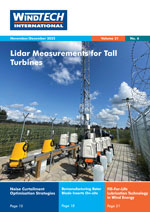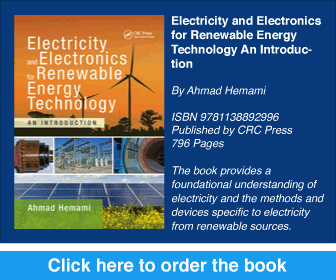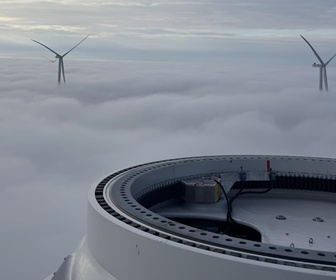- Category: Articles
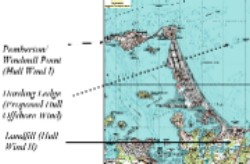 Hull, Massachusetts, is a remarkable US coastal community. Since 2001 Hull Municipal Light Plant (HMLP) has owned and operated ‘Hull Wind I', the largest wind turbine (660kW) that had been installed in the state up to that time. More recently (2006), HMLP installed a second, larger (1.8MW) wind turbine, Hull Wind II. Now the town has started a project that is intended to result in the installation of an offshore wind farm, with a capacity of approximately 14MW. This project has two unusual features, at least in the USA. First of all, it involves a community owned and operated wind energy facility that will supply a large fraction of the community's electrical requirement. Second, this third wind energy facility will be offshore. In this article, the overall scope of this project, its key technical aspects and its current status will be described.
Hull, Massachusetts, is a remarkable US coastal community. Since 2001 Hull Municipal Light Plant (HMLP) has owned and operated ‘Hull Wind I', the largest wind turbine (660kW) that had been installed in the state up to that time. More recently (2006), HMLP installed a second, larger (1.8MW) wind turbine, Hull Wind II. Now the town has started a project that is intended to result in the installation of an offshore wind farm, with a capacity of approximately 14MW. This project has two unusual features, at least in the USA. First of all, it involves a community owned and operated wind energy facility that will supply a large fraction of the community's electrical requirement. Second, this third wind energy facility will be offshore. In this article, the overall scope of this project, its key technical aspects and its current status will be described.- Category: Articles
Harnessing a Tried and Tested Novel Technology
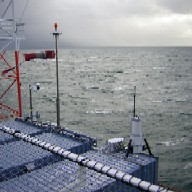 Remote sensing methods such as sodar and laser anemometry (lidar) offer a means of obtaining accurate wind profiles for wind resource assessment, and hence reduce costs and risks associated with the siting of fixed masts. However, these techniques need to be extensively validated in order to obtain widespread acceptance by the industry. At the forefront of this process, QinetiQ, a UK research and development laboratory, has developed ZephIR - a laser anemometer which exploits decades of lidar research. QinetiQ began a programme to develop a commercial fibre-based lidar in 2001 in close collaboration with Risø, Denmark's National Research Centre; its ZephIR product is now becoming an established tool for wind profiling in the wind energy industry. In March 2007 Natural Power exclusively licensed the technology from QinetiQ to bring ZephIR to the global market and commence serial production. ZephIR has been tried and tested by the community, including an offshore evaluation programme with Germanischer Lloyd's WindTest on the FINO1 platform, and has demonstrated 100% availability and exceptional correlations with fixed masts. Systems have been deployed successfully around the world in many demanding applications that illustrate the flexibility and robustness of the solution.
Remote sensing methods such as sodar and laser anemometry (lidar) offer a means of obtaining accurate wind profiles for wind resource assessment, and hence reduce costs and risks associated with the siting of fixed masts. However, these techniques need to be extensively validated in order to obtain widespread acceptance by the industry. At the forefront of this process, QinetiQ, a UK research and development laboratory, has developed ZephIR - a laser anemometer which exploits decades of lidar research. QinetiQ began a programme to develop a commercial fibre-based lidar in 2001 in close collaboration with Risø, Denmark's National Research Centre; its ZephIR product is now becoming an established tool for wind profiling in the wind energy industry. In March 2007 Natural Power exclusively licensed the technology from QinetiQ to bring ZephIR to the global market and commence serial production. ZephIR has been tried and tested by the community, including an offshore evaluation programme with Germanischer Lloyd's WindTest on the FINO1 platform, and has demonstrated 100% availability and exceptional correlations with fixed masts. Systems have been deployed successfully around the world in many demanding applications that illustrate the flexibility and robustness of the solution.By Michael Harris, QinetiQ Fellow, QinetiQ Ltd, and Ian Locker, Director-ZephIR, Natural Power
.- Category: Articles
Solutions to Tower Challenges in New Damper Technology
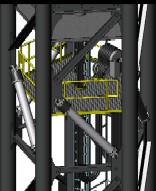 Damping of large structures to enable more cost-effective systems has been demonstrated by LORD Corporation's engineering team as they work with the Wind Tower Systems design division of Wasatch Wind (WW). WW is a new development venture based in Heber City, Utah, allied to Brigham Young University and Windward Engineering (an aero-elastic turbine modeller). WW's Wind Tower Systems division has developed a unique space frame tower to support large wind turbines, made up of segments of steel tubes assembled into a 3D matrix. The lighter tower is made possible through the use of proprietary damped struts in specific tower locations. The struts are structural members of the tower, and comprise an outer tube material of lower stiffness than the inner, so that a relative motion is created between them during dynamic loading events from the turbine. For aesthetic reasons, and to prevent bird perching, the frame is covered overall with a non-structural skin, essentially achieving the look of a typical steel tube tower. This new design enables installed-tower cost reductions of 20 to 35%, depending on turbine size.
Damping of large structures to enable more cost-effective systems has been demonstrated by LORD Corporation's engineering team as they work with the Wind Tower Systems design division of Wasatch Wind (WW). WW is a new development venture based in Heber City, Utah, allied to Brigham Young University and Windward Engineering (an aero-elastic turbine modeller). WW's Wind Tower Systems division has developed a unique space frame tower to support large wind turbines, made up of segments of steel tubes assembled into a 3D matrix. The lighter tower is made possible through the use of proprietary damped struts in specific tower locations. The struts are structural members of the tower, and comprise an outer tube material of lower stiffness than the inner, so that a relative motion is created between them during dynamic loading events from the turbine. For aesthetic reasons, and to prevent bird perching, the frame is covered overall with a non-structural skin, essentially achieving the look of a typical steel tube tower. This new design enables installed-tower cost reductions of 20 to 35%, depending on turbine size.By Bryan Haltom, Market Development Manager, LORD Corporation, USA
.- Category: Articles
More Accurate Forecasts can be Obtained by Using Neural Networks
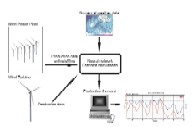 Predictions of the power production for a wind power plant or collection of wind power plants can be improved by using so-called self-adaptive models. These models learn continuously from past experience and are thus able to adjust to changing circumstances, such as seasonal changes, small changes in weather model set-up, or even changes to the numbers or types of wind turbines. This article compares the predictions of Vejr2's neural network model with that of the company's advanced physical model. The neural network model is seen to perform significantly better than the physical model.
Predictions of the power production for a wind power plant or collection of wind power plants can be improved by using so-called self-adaptive models. These models learn continuously from past experience and are thus able to adjust to changing circumstances, such as seasonal changes, small changes in weather model set-up, or even changes to the numbers or types of wind turbines. This article compares the predictions of Vejr2's neural network model with that of the company's advanced physical model. The neural network model is seen to perform significantly better than the physical model.
By Anna Hilden, Vejr2 A/S, Denmark
.- Category: Articles
Insulating Fluids Affect the Environmental and Fire Risks of Wind Turbines
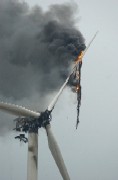 Transformers for wind turbines are generally hidden away in a green box next to the tower. However, out on the open sea, they tend to be placed in the gondola itself, on the outside of the turbine or even on separate platforms when their role is as a central offshore transformer station for a large wind farm. What most transformers have in common is that they have until now been insulated and cooled using mineral oil. Yet the fact that these insulating fluids are flammable and pose an environmental risk makes it necessary to look for alternatives, especially for use on sensitive sites.
Transformers for wind turbines are generally hidden away in a green box next to the tower. However, out on the open sea, they tend to be placed in the gondola itself, on the outside of the turbine or even on separate platforms when their role is as a central offshore transformer station for a large wind farm. What most transformers have in common is that they have until now been insulated and cooled using mineral oil. Yet the fact that these insulating fluids are flammable and pose an environmental risk makes it necessary to look for alternatives, especially for use on sensitive sites.By Florian Gerlach, Journalist, Germany
.- Category: Articles
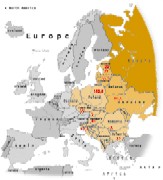 Investors' reduced risk perception has generated a noticeable trend in the financing of wind farms through the bond market. Project developers welcome bond financing since it provides longer term and less expensive financing than conventional loans that mature in 12-14 years. Banks are also financing projects by bundling assets from several wind farms to provide collateral for bonds.
Investors' reduced risk perception has generated a noticeable trend in the financing of wind farms through the bond market. Project developers welcome bond financing since it provides longer term and less expensive financing than conventional loans that mature in 12-14 years. Banks are also financing projects by bundling assets from several wind farms to provide collateral for bonds.By Rosa Tarragó, Commerzbank AG, Germany
- Dispatchable Wind
- The AXTRA Turbine
- Maritime and Marine Risk Assessment of Calamitous Oil Spills
- Motorwind
- Cracks at Foundations
- Predictive Maintenance Services
- Long-Duration Wind (Aero) Generator Back-Up
- Magenn Air Rotor System (MARS)
- Energy Prediction Uncertainty
- Demand Response
- Can Wind Energy and Radio Co-exist?
- Wind Power Generation in Sri Lanka
- The European Offshore Supergrid
- Wind Energy Forecasting in Ireland
- Reliable Ultimate Loads for Wind Turbines
- A Computational Tool to Aid the Electric Power Utilities
- Clipper’s Liberty Turbine
- Reducing Dynamic Loading of Towers
- Wind Turbines and Earthquakes
- Generating Wind Energy Using Kites
- Technology to Catch the Wind
- Sahara Wind’s Integrated Development Approach
- Wind Energy and Hydrogen Balancing
- Damage on Wind Turbines
- Brakes in Modern Wind Turbines
- A Fresh Breeze for Gears
- GyroTorque, Continuously Variable Transmission (GTCVT)
- Cost of Lost Production
- The Sound of an Endless Train
- SmartEnergy Spire



